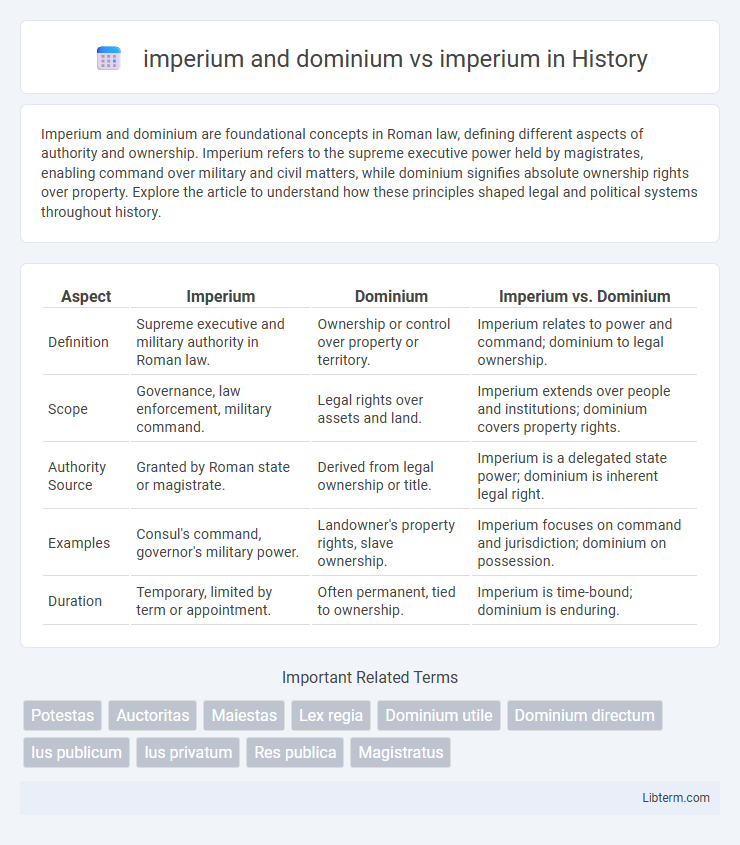Imperium and dominium are foundational concepts in Roman law, defining different aspects of authority and ownership. Imperium refers to the supreme executive power held by magistrates, enabling command over military and civil matters, while dominium signifies absolute ownership rights over property. Explore the article to understand how these principles shaped legal and political systems throughout history.
Table of Comparison
| Aspect | Imperium | Dominium | Imperium vs. Dominium |
|---|---|---|---|
| Definition | Supreme executive and military authority in Roman law. | Ownership or control over property or territory. | Imperium relates to power and command; dominium to legal ownership. |
| Scope | Governance, law enforcement, military command. | Legal rights over assets and land. | Imperium extends over people and institutions; dominium covers property rights. |
| Authority Source | Granted by Roman state or magistrate. | Derived from legal ownership or title. | Imperium is a delegated state power; dominium is inherent legal right. |
| Examples | Consul's command, governor's military power. | Landowner's property rights, slave ownership. | Imperium focuses on command and jurisdiction; dominium on possession. |
| Duration | Temporary, limited by term or appointment. | Often permanent, tied to ownership. | Imperium is time-bound; dominium is enduring. |
Defining Imperium: Origins and Meaning
Imperium originates from Roman law, signifying supreme authority granted to magistrates or commanders, encompassing military and administrative power within the state. Distinct from dominium, which refers to ownership or property rights, imperium embodies the right to command and enforce laws over people and territory. Understanding imperium is crucial for studying state sovereignty and governance in ancient Roman political theory.
Understanding Dominium: Legal and Political Context
Dominium refers to the legal ownership and control over property or territory, distinct from imperium, which signifies sovereign authority or governmental power. In legal and political contexts, dominium emphasizes proprietary rights, enabling individuals or states to exercise exclusive dominion over assets without necessitating sovereign enforcement. Understanding dominium clarifies the separation between possession rights and the broader exercise of state imperium, essential for distinguishing private property law from public authority.
Historical Evolution of Imperium and Dominium
The historical evolution of imperium and dominium reflects distinct legal and political concepts in Roman law, with imperium denoting supreme authority exercised by magistrates or generals, while dominium referred to ownership rights over property. Over time, imperium evolved from military and judicial control to broader state sovereignty, whereas dominium remained focused on private property and land ownership. This differentiation shaped modern public versus private law, influencing the development of state power and property rights in Western legal traditions.
Key Differences Between Imperium and Dominium
Imperium refers to the sovereign authority to command and enforce laws within a political or military context, while dominium specifically denotes ownership or property rights over assets or land. Imperium grants regulatory and coercive powers exercised by state officials or rulers, whereas dominium establishes legal possession and control by individuals or entities. The key difference lies in imperium's focus on governance and public authority, contrasted with dominium's emphasis on private property rights and ownership control.
Imperium vs Imperium: Conflicting Authorities
Imperium refers to the supreme executive power in Roman law, encompassing military and administrative authority, while dominium signifies ownership rights over property. Conflicts arise when multiple holders of imperium, such as provincial governors or magistrates, exercise overlapping powers leading to jurisdictional disputes and challenges to centralized control. These clashes highlight the complexities of maintaining a coherent command structure within the Roman Republic and Empire, emphasizing the tension between competing centers of imperium rather than property rights under dominium.
Roman Law: The Roots of Imperium and Dominium
In Roman Law, imperium referred to the supreme authority wielded by magistrates to command and enforce laws within the state, while dominium denoted private ownership rights over property. Imperium encompassed powers such as military command and civil jurisdiction, enabling control over people and territories, whereas dominium related specifically to control over things, reflecting proprietary rights. The distinction between imperium and dominium established foundational legal principles differentiating public authority from private property rights in Roman legal tradition.
Medieval Interpretations of Imperium and Dominium
Medieval interpretations distinguished imperium as supreme authority over territories and military power, while dominium referred to ownership and control of property or land. Imperium encompassed political sovereignty and the right to govern populations, often held by emperors or kings, whereas dominium was more limited to private rights and feudal lordship. This differentiation underpinned legal and hierarchical structures in medieval Europe, influencing the relationship between secular rulers and vassals.
Modern Legal Perspectives on Imperium and Dominium
Modern legal perspectives distinguish imperium as the sovereign authority to govern and enforce laws, while dominium pertains to property rights and ownership. Imperium grants states the power to regulate public order and exercise jurisdiction, whereas dominium emphasizes private ownership and control over assets. This separation reflects contemporary constitutional frameworks balancing state sovereignty with individual property rights.
Imperium and Dominium in Colonial Contexts
Imperium and dominium represent distinct legal concepts crucial to colonial governance, where imperium refers to the sovereign authority to govern and enforce laws, while dominium denotes ownership and control over land and resources. Colonial powers exercised imperium to establish political dominance and legal jurisdiction over indigenous populations, whereas dominium asserted their property rights and economic exploitation of territories. Understanding this distinction clarifies how colonial administrations maintained control through legal frameworks separating political authority from proprietary claims.
Comparative Analysis: Imperium, Dominium, and Sovereignty
Imperium denotes supreme command or authority primarily exercised by a state or ruler over governance and military matters, while dominium refers to ownership rights, highlighting control over property and assets. Sovereignty encompasses both imperium and dominium, representing the ultimate legal authority of a state to govern itself without external interference. Comparative analysis reveals that imperium emphasizes authoritative power, dominium centers on proprietary rights, and sovereignty integrates these concepts to establish full autonomous governance.
imperium and dominium Infographic

 libterm.com
libterm.com